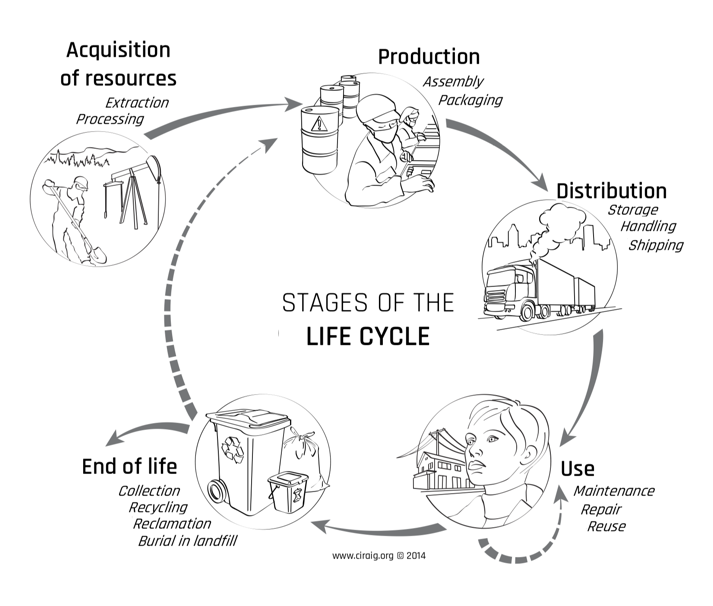Introduction
Among the items that are actively used by people throughout their lives, coffee glasses are of particular importance. According to Nikolovska, more than three cups of coffee are drunk by an American every day. Still, to assert the essence of the problem, it is necessary to represent the entire production process of an ordinary coffee cup. To be more specific, Starbucks was chosen as it is one of the most famous chains, whose branches are spread worldwide.
Composition
It is of primary importance to determine the composition of the paper cup so that the reader can have an idea of what production processes may be present here. In the case of single-complex composition, the boiling water would soften the cellulose walls, and the drink would be spilled. To neutralize the adverse effect, a polyethylene (PE) sputtering is added to the cellulose, which increases the thermal resistance. Moreover, an essential attribute of the cup is a plastic lid made of polystyrene. Starbucks cups are decorated with pictures, which are applied by printing ink. Finally, in cases where the drink is boiling, the cup is packaged in a cardboard holder.
The first stage: pulp preparation
There are at least two options for a raw material search for Starbucks paper cups: the use of primary material and recycled, secondary. According to Smith, the company uses only 10% recycled pulp, which means that the prevailing number of materials are supplied directly from certified forests (Smith; Huhtamaki). Wood from coniferous trees is placed in aqueous acid solutions, where it is converted into swollen cellulose. The component is dried, formed into large rolls, and then sent to production.
The second stage: ink
Dark green and black inks are used to create a unique Starbucks glass design. There are at least two ways to apply ink to products, namely food colorant or UV-curing ones (Printing Paper Cups). In the first case, the ink is safer and is applied to the cardboard in a form not yet assembled. UV-curing materials are more dangerous, and there is always the possibility of ink penetration into the drink.
The third stage: cup formation
Multi-kilogram cellulose rollers are placed in the forming conveyors, where they are automatically cut to even geometric shapes from which the cup will be folded. If the container is intended for hot drinks, then at this stage, rolls of paper are used, on which the PE coating was previously applied (Butler). Cut shapes are folded into the cup, the bottom is completed, and upper edges are cut.
The fourth step: PS cover and paper holder
Although polystyrene (PS) refers to carcinogenic materials, it is used to produce a plastic cap tightly adjacent to the cup. Typically, the plastic layer is loaded on a conveyor belt under the influence of blades and press, forming a lid of the necessary shape and diameter (The Long And Sordid Journey). Concurrently, creating a cardboard holder takes place: at this stage, there is an automated cutting of highly porous cardboard with much air.
Particular attention should be paid to the product testing discussion. The supplier should not allow situations where the cup breaks under the influence of hot water, or high temperature stimulates the diffusion of ink into the beverage. Certification and examination of goods require special attention, so before launching, the company must check the quality. The product is randomly selected from a sample, after which it is examined for leaks or ruptures in the bonded material. In case the problem is detected, the whole line is stopped and investigated.
The fifth stage: delivery
Starbucks, like other coffee houses, traditionally purchases paper cups and separate plastic lids. This can be seen if the reader studies the lid’s appearance: unlike the cup, there is no logo or brand name. The coffee shop buys a large number of containers from manufacturers, after which they are delivered to branches. Thus, every time a buyer orders a coffee cup, workers take a new container, which has come such a long way before getting into the trash.

Works Cited
“At Our Factory: Making of Paper Cups.” YouTube, uploaded by Huhtamaki, 2017.
Butler, Cora. “Process Of Manufacturing Paper Cups.” Innfe Media Inc, 2016.
“The Long And Sordid Journey Of A Disposable Coffee Cup.” Zoetica. 2018.
Nikolovska, Hristina. “33 Coffee Statistics to Wake You Up.” Disturbmenot. 2019.
“Printing Paper Cups with Food Safety in Mind.” Scyphus. 2020.
Smith, Aaron. “Starbucks Offers $10 Million for Ideas on a Better Cup.” CNN Business. 2018.